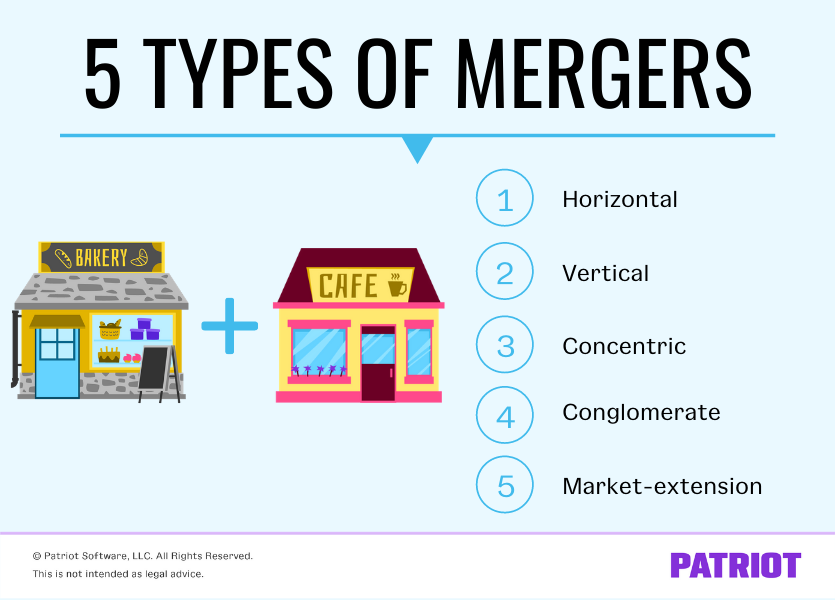At some point or another, you may want to join forces with another business to help boost profits or cut costs. One way to do this is to merge your business with another company through a merger. There are a variety of mergers to choose from. Are you ready to explore the different types of mergers? If so, then keep reading.
What is a merger?
First things first, what exactly is a merger? A merger is an agreement where two companies join together to form one new company. In short, a merger is the combination of two companies into a single legal entity. With a merger, both companies have to voluntarily merge with each other.
There are a number of reasons why businesses decide to merge. Businesses might decide to merge to:
- Expand into new segments
- Gain market share
- Increase efficiency
- Get a competitive advantage
- Cut costs
- Diversify offerings
- Increase profits
Some companies use a merger as a business exit strategy. Other companies may use a merger for business restructuring.
Businesses that merge are typically similar in terms of size, customer count, and scale of operations.
After a merger occurs, shares of the newly-merged company are distributed to existing shareholders of both businesses.
Mergers vs. acquisitions
If you’re familiar with the term merger, then you’ve probably seen or heard it along with the word “acquisition.” Although they are often used interchangeably, mergers and acquisitions are not the same thing.
An acquisition is when one company takes over another entity and becomes the new owner of said entity. With an acquisition, one company purchases most or all of another company’s shares and gains control of the other company.
As you read above, a merger is when two companies join forces and become one. With mergers, two companies team up together, and one business does not acquire the other one.
5 Types of mergers
There are a few different types of company mergers to choose from. The most common types of mergers are:
- Horizontal
- Vertical
- Concentric
- Conglomerate
- Market-extension
Ready to explore all of the merger options businesses can choose from? Check out how they compare below.

Horizontal
A horizontal merger is a merger between two companies in the same industry. This type of merger involves two businesses that offer the same products or services to the same kinds of customers. With a horizontal merger, the two businesses are direct competitors of one another.
The goal of a horizontal merger is to increase reach and market share by coming together as one company.
For example, say you own a bakery and decide to merge with another bakery in town. You would be merging with a direct competitor and would be fusing together to form one bakery.
Horizontal mergers are more common in industries with fewer companies because competition tends to be higher.
Vertical
A vertical merger occurs when two companies that are in the same industry but at different points in the supply chain merge operations. Companies in a vertical merger produce different products or services along the supply chain and work toward producing one final product.
Vertical mergers are typically done to reduce costs, improve logistics, and improve operating efficiency.
An example of a vertical merger would be an auto parts industry merging with a company that supplies raw materials for auto parts.
Concentric
A concentric, or congeneric or product-extension, merger is when two companies merge that are in the same market but sell different, yet related products or services. This type of merger allows the companies to group together their products or services and access a larger set of consumers.
With a concentric merger, a company merges with another company that sells products or services to the same customers. Because they sell different products, they are indirect competitors.
These types of mergers tend to drive new business because they become a one-stop shop for customers. By offering more of the products or services both businesses’ customers are looking for, they can attract more consumers.
An example of a concentric merger would be if a catering company merged with a party planning company. They are both in the same industry, have different offerings, and have related products or services.
Conglomerate
A conglomerate merger occurs when two or more companies in different industries or geographic locations come together to broaden their range of services and products.
With a conglomerate merger, the companies involved engage in completely unrelated business activities. For example, one may be a software company and the other may be a clothing business.
There are two types of conglomerate mergers:
- Pure: Involves two companies that have nothing in common and no similar offerings.
- Mixed: Companies are looking to expand their offerings or market reach by joining with another company.
A business may take part in a conglomerate merger to reach a wider market and expand its customer base.
Market-extension
A market-extension merger is a merger between companies in different markets that sell similar things. With this type of merger, companies sell the same or similar products or service but compete in different markets.
Companies that choose the market-extension merger route are typically looking to gain access to a bigger market and client base.
Comparing the types of business mergers: Chart
Want to skim over the different types of mergers? Check out our handy chart to quickly find out the differences between each type of merger.
| Type of Merger | How it Works |
|---|---|
| Horizontal | A merger between two companies that are in the same industry and are direct competitors of each other. |
| Vertical | Two companies that are in the same industry but at different points in the supply chain merge operations. |
| Concentric / Congeneric / Product-extension | Companies merge that are in the same market but sell different, yet related products or services. |
| Conglomerate | Two or more companies in different industries or geographic locations come together to broaden their range of services and products. This merger can be pure or mixed. |
| Market-extension | A merger between companies in different markets that sell similar products or services. |
Need to streamline your newly-merged business’s books? Patriot’s online accounting makes it a breeze to track income and expenses. Plus, we offer free, USA-based support. Try it for free today!
This is not intended as legal advice; for more information, please click here.



